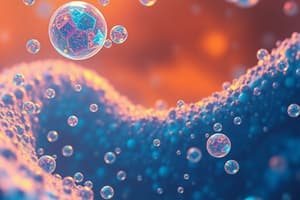Podcast
Questions and Answers
Which dressings are recommended for dry to minimally exudative wounds with or without depth?
Which dressings are recommended for dry to minimally exudative wounds with or without depth?
- Hydrocolloid dressings
- Alginate dressings
- Hydrogel dressings (correct)
- Polyurethane foam dressings
What type of wound is hydrocolloid dressing recommended for?
What type of wound is hydrocolloid dressing recommended for?
- Minimally exudative wounds
- Partially or fully exudative wounds (correct)
- Superficial or deep wounds
- Dry wounds
What is the primary purpose of polyurethane foam dressings?
What is the primary purpose of polyurethane foam dressings?
- To absorb moderate-to-heavy exudates (correct)
- To hydrate a wound
- To hold wound exudate away from a wound bed
- To create a moist environment and promote autolysis, granulation, and epithelialization
What is the purpose of polyurethane foam dressings?
What is the purpose of polyurethane foam dressings?
Which type of dressing is made of elastomeric, adhesive, and gelling agents?
Which type of dressing is made of elastomeric, adhesive, and gelling agents?
What is the main characteristic of alginate dressings?
What is the main characteristic of alginate dressings?
Flashcards are hidden until you start studying
Study Notes
- There are different classes of wound dressings available.
- Hydrocolloid dressings are made of elastomeric, adhesive, and gelling agents.
- Hydrocolloid dressings are recommended for minimally-to-moderately exudative partial- and full-thickness wounds.
- Hydrogel dressings are glycerin- or water-based dressings designed to hydrate a wound.
- Hydrogel dressings are recommended for dry to minimally exudative wounds with or without depth.
- Polyurethane foam dressings are sheets of foamed polymers that contain small open cells capable of holding wound exudate away from a wound bed.
- Foam dressings are used as primary or secondary dressings to absorb moderate-to-heavy exudates.
- Alginate dressings include calcium alginate materials, which are manufactured from natural material.
- Alginates create a moist environment and thus promote autolysis, granulation, and epithelialization.
- Alginates and fiber gelling dressings are changed as often as daily; or they are left in place for several days.
Studying That Suits You
Use AI to generate personalized quizzes and flashcards to suit your learning preferences.




